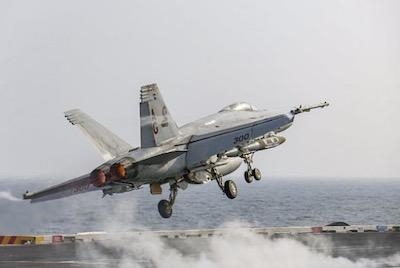Shifts Focus To Readiness Sustainment
Commander, Naval Air Forces (CNAF) announced Sept. 24 that Naval Aviation has achieved its Secretary of Defense-mandated readiness target of an 80 percent mission-capable (MC) rate for both its operational F/A-18 E/F “Super Hornet” and EA-18G “Growler” fleets.

After a year of reforms across Navy squadrons, maintenance and supply depots and other key readiness-enabling commands, Super Hornet and Growler readiness each stand above 80 percent of Primary Mission Aircraft Inventory (PMAI), at 343 and 95 aircraft, respectively.
Last year, with the Navy’s MC rate hovering near 50 percent, then-Secretary of Defense James Mattis directed the Air Force, Navy and Marine Corps to reach an 80 percent MC rate across their fighter and strike fighter aircraft squadrons. To achieve this goal, the Naval Aviation Enterprise (NAE) implemented the Naval Sustainment System-Aviation (NSS-A). The NSS-A initiative leverages best practices from commercial industry to update and improve aspects of Naval Aviation’s maintenance practices in squadrons as well as at intermediate and depot Fleet Readiness Centers.
Additional reform efforts greatly improved supply chain management, engineering practices, governance activities and safety. Initially, NSS-A focused on getting the Navy F/A-18 Super Hornet fleet healthy, but quickly grew to include the Navy’s EA-18G Growler fleet due to the similarities in the two platforms. Ultimately, the Navy and Marine Corps will apply NSS-A reforms to recover and sustain readiness and improve safety for each type, model and series of aircraft.
According to Vice Adm. DeWolfe H. Miller III, the Navy’s “Air Boss” (CNAF), after a decade of regularly maintaining between 250-260 MC F/A-18s, the Navy is now sustaining over 320 MC Super Hornets and surged to attain service goals of 341 MC Super Hornet and 93 MC Growler aircraft this month. “This has been a year of results for Naval Aviation. I am incredibly proud of our Sailors, civilian teammates and industry partners. They developed and implemented the NSS and then drove readiness numbers that haven’t been seen in over a decade. Their results are incredible and their passion for improvement is inspirational.” said Miller.
“The tremendous efforts of our Fleet Readiness Centers were vital to achieving our readiness goals,” said Vice Adm. Dean Peters, Commander, Naval Air Systems Command. “I am extremely proud of the accomplishments of the Sailors and artisans that keep us mission focused.”
Rear Adm. Roy Kelley, Commander, Naval Air Forces, Atlantic (CNAL), pointed to the leading indicator of aviation readiness moving in the right direction: aviator flight hours. “This is the first year in some time that we have executed our allocation of flight hours completely,” said Kelley. “That stands as a sign of health that we have a lot of ‘up’ aircraft, and that the parts are moving. We’re getting healthy and we’re on the right track.”
The Air Boss agreed, adding that achievement of the 80 percent goal was an important milestone, but not a completed mission. “To be clear, there is no finish line to the NSS effort,” he said. “We don’t get to choose when we are called to fight. Sustainment is the key. Continuously improving the reforms implemented by our military, civilian and industry teams will be critical in maintaining our advantage in this age of great power competition.”
(Image provided with U.S. Navy news release)
 NTSB Prelim: Piper PA-23
NTSB Prelim: Piper PA-23 ANN FAQ: Submit a News Story!
ANN FAQ: Submit a News Story! Classic Aero-TV: One Mans Vietnam
Classic Aero-TV: One Mans Vietnam ANN's Daily Aero-Linx (07.03.25)
ANN's Daily Aero-Linx (07.03.25) ANN's Daily Aero-Term (07.03.25): High Speed Taxiway
ANN's Daily Aero-Term (07.03.25): High Speed Taxiway



